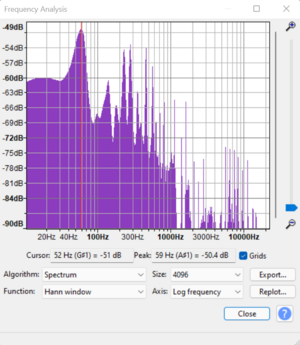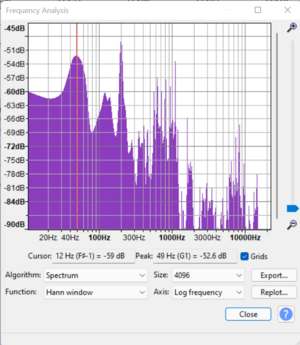Course:PHYS341/2022/Project13
Wind Chimes

Often seen hanging outside homes, temples, shrines, etc., wind chimes harness the force of wind to produce (musical) sounds. Although likely to be overlooked, the wind chime commands the spaces it inhabits as it acts as both a sonic and visual decorative art. Among its many qualities, visual and sonic, perhaps its sonic qualities are especially interesting to investigate.
History
Also referred to as wind bells, wind chimes are tied to ancient civilizations of Asia. First invented in prehistoric times, evidence of the first chimes date back to 3000BC where bells were found at archaeological sites in Southeast Asia.[1]
Wind chimes were often hung from eaves of shrines and temples as they were seen as religious objects that drove away evil spirits and drew in kind ones instead. Nowadays, wind chimes can be seen hanging in gardens, on front porches, and even inside homes. Wind chimes brought into these Western or secular settings (overlooking front porches or gardens) can be seen as an adoption of the notions and customs tied to the benefits of the instrument's religious roots.[2]
In the nineteenth century, instrumental chimes were specially tuned and curated for use in orchestras. Higher-quality wind chimes then followed this progress, and with the help of developing technologies, are now more precisely cut and tuned to musical scales of both modern and ancient times.[3]
Materials & Definitions

Wind chimes can be visual described as a cluster of similar objects, whereby the most common and simplest appearance of wind chimes consist of metal pipes or tubes hanging from a central support.[4] In the case of tuned wind chimes, aluminum is often the material of choice due to their ease of tuning. As wind chimes are also often placed in outdoor spaces, aluminum is also ideal in terms of their long decay times.[5]
Tuned wind chimes are an example of a tuned idiophone, an idiophone being a musical instrument that produces musical sounds when struck. In that sense, wind chimes can be seen as percussion instruments that, by the definition of tuned idiophones, specifically produce tones of a definite pitch. Other examples of tuned idiophones are xylophones, marimbas, and bells. These instruments are opposed to untuned idiophones such as cymbals and the triangle which do not produce tones of a definite pitch.[6]
Sound Production
With most wind chimes, the production of (musical) sounds is a result of the pipes or bars coming into contact with a central object of some sort. This collision, prompted by the force of wind, causes the pipes or bars of the wind chimes to vibrate.
The pipes or bars of wind chimes vibrate transversely similarly to a string. At the same time, unlike strings, the pipes or bars of wind chimes vibrate even with no tension. Instead, the elastic forces within the material itself act as the necessary restoring forces that perpetrate the vibrations. For bars and pipes that are identical in size as well as shape, their vibration frequencies will match with the velocities of sound in the materials.[7]
Interestingly with wind chimes, the pitch of the tone one hears does not correspond to the actual vibration frequency that the pipes or bars are producing. This is the case because most percussion instruments, like chimes, have overtones but not harmonics. One characteristic of these non-harmonic instruments is that a subjective tone will be created by the human auditory system. In the case where the lowest frequencies are either too weak or missing, the heard pitch is often identified as the missing fundamental frequency. This phenomenon associated with non-harmonic instruments can be labeled as a “virtual pitch” and can be connected with wind chimes since they have no apparent harmonic series associated with them.[8][9]



Spectral Analysis
Conducting a spectral analysis of the musical sounds produced by wind chimes will help to better visualize and understand that wind chimes vibrate with frequencies that are not harmonic.
In order to provide a range of examples, a spectral analysis was conducted three times on three different versions of wind chime sounds. The process consisted of the following steps:
- A spectrum graph for a section of recorded wind chime sounds is plotted. (The spectrum graphs can be seen from figures 1-3)
- The frequencies of the first five peaks are recorded
- The ratio between those frequencies and the frequency of the lowest peak is recorded. (Tables with this information can be seen below).
| Peak # | Frequency | Ratio Between Frequency and the Frequency of the Lowest Peak |
|---|---|---|
| 1 | 59Hz | - |
| 2 | 95Hz | 1.61 times the lowest peak |
| 3 | 123Hz | 2.08 times the lowest peak |
| 4 | 178Hz | 3.02 times the lowest peak |
| 5 | 228Hz | 3.86 times the lowest peak |
| Peak # | Frequency | Ratio Between Frequency and the Frequency of the Lowest Peak |
|---|---|---|
| 1 | 49Hz | - |
| 2 | 117Hz | 2.39 times the lowest peak |
| 3 | 199Hz | 4.04 times the lowest peak |
| 4 | 276Hz | 5.63 times the lowest peak |
| 5 | 347Hz | 7.08 times the lowest peak |
| Peak # | Frequency | Ratio Between Frequency and the Frequency of the Lowest Peak |
|---|---|---|
| 1 | 41Hz | - |
| 2 | 95Hz | 2.32 times the lowest peak |
| 3 | 120Hz | 2.93 times the lowest peak |
| 4 | 202Hz | 4.93 times the lowest peak |
| 5 | 227Hz | 5.54 times the lowest peak |
As the ratios between the frequencies of the first five peaks and the frequency of the lowest peak are inconsistent unlike the ratios that would be true of a standard harmonic, the observation made from this analysis is that wind chimes do not have harmonic spectra.
Tuning
Wind chimes, in its broader definition, are not all tuned. Wind chimes made out of seashells, for example, would be quite difficult to tune. That being said, with increased accessibilities to technologies, higher-end chimes and chimes used in orchestras are indeed crafted to match certain sounds or scales. These chimes, as aforementioned, are mostly made of metal or more specifically aluminum.
For the most part, high-end wind chimes, as well as tuned chimes used in orchestras, are tuned using computer technologies and complex mathematical equations. The musical sounds are resultant of a mixture of components including the pipe’s length, material, thickness, etc. In addition, where the pipes are being struck, and how they are connected to a top piece—whether it is closed or open—also affect the final musical sound produced by a wind chime. As there are so many varying factors that constitute the sounds of a wind chime, and so many variations of the instrument itself, it proves difficult to pinpoint one exact way of tuning.
One way of tuning that might be used for DIY chimes is by cutting a desired material to a particular length and then trimming it through trial and error to match a specific note played on, for example, a piano (this assumes other properties such as material and thickness are the same). Although it might be easier to refer to a pre-existing chart or more accurate to use a mathematical equation, what is essentially being done is finding the length of material that will have a natural frequency that matches the desired note.
As tuned chimes are often based off of scales, such as a pentatonic scale, it is likely that the notes chosen for the wind chimes correspond to the notes of that scale. Since the notes that make up scales have simple intervals with simple ratios of fundamental frequencies, the harmonics of those notes will likely avoid dissonance due to the closely spaced frequencies. Due to these characteristics, by basing the “tuning” of wind of chimes off the notes of scales, tuned chimes can sound quite melodic.[10]
References
- ↑ "Wind Chime ." How Products Are Made. . Encyclopedia.com. 28 Mar. 2022 <https://www.encyclopedia.com>.
- ↑ "Wind Chime ." How Products Are Made. . Encyclopedia.com. 28 Mar. 2022 <https://www.encyclopedia.com>.
- ↑ "Wind Chime ." How Products Are Made. . Encyclopedia.com. 28 Mar. 2022 <https://www.encyclopedia.com>.
- ↑ "Wind Chime ." How Products Are Made. . Encyclopedia.com. 28 Mar. 2022 <https://www.encyclopedia.com>.
- ↑ Rossing, Thomas D., Junehee Yoo, and Andrew Morrison. "Acoustics of Percussion Instruments: An Update." Acoustical Science and Technology, vol. 25, no. 6, 2004, pp. 406-412.
- ↑ Fletcher, Neville H., et al. The Physics of Musical Instruments. Springer New York, New York, NY, 1998;2013;2008;2012;, doi:10.1007/978-0-387-21603-4.
- ↑ Fletcher, Neville H., et al. The Physics of Musical Instruments. Springer New York, New York, NY, 1998;2013;2008;2012;, doi:10.1007/978-0-387-21603-4.
- ↑ Fletcher, Neville H., et al. The Physics of Musical Instruments. Springer New York, New York, NY, 1998;2013;2008;2012;, doi:10.1007/978-0-387-21603-4.
- ↑ Oliver, Douglas L. Analysis of a Pseudo-Harmonic Tubular Bell, ProQuest Dissertations Publishing, 2017.
- ↑ Van Raamsdonk, Mark. “Lecture 24-1” Physics 341, 14 Mar. 2022, University of British Columbia.